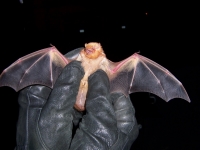This "From the Archive" post first appeared in our September/October 2007 issue of our newsletter. Please enjoy this look back at our past.
If you are interested in working with the bats, birds, mammals, plants, bugs and snakes that live in Riverside Park, please contact Jennifer Callaghan, Research Assistant, at This email address is being protected from spambots. You need JavaScript enabled to view it..
You may have noticed a strange-looking structure with a solar panel standing above the prairie plants in the South Oak Grove. I’ve had many curious dog-walkers ask me why it’s there. Strangely, no one recognized it for what it is: a long-term remote bat monitoring station. Chances are the average park user is not a chiropterist* (bat scientist) by profession, but even bat scientists may not recognize this contraption because it represents cutting edge technology in bat research.
How does it work? During the day, solar panels charge up a digital sound recorder that is tuned to record ultrasound in the 20-110kHz range, most commonly used by bats but beyond the range of human hearing. By night it simply listens for and records bat sounds. Every two weeks we change a disk, upload the data and voila! Because each species of bat leaves a unique “fingerprint” in the form of a sound frequency pattern, we can tell which species have been flying around the prairie on any given night, at any given time. Analyzing the sonograms can also tell us if a bat is hunting through echolocation or whether it has found prey and is closing in.
Dave Redell, Wisconsin’s own “Batman” of the Wisconsin Department of Natural Resources, installed five of these stations across the state. Data collected will help determine the timing of bat migration, species distribution, migration patterns and behavior patterns. Riverside Park was chosen in part because of its urban location along a migration corridor (Milwaukee River), but also because of the community presence of the [Center] and our commitment to long-term environmental education and community science research.
The permanent monitoring station is exciting, but it gets better. The DNR also has a portable bat-monitoring station with a built-in GPS unit that allows researchers to walk through an area recording the presence, location and species identification of individual bats. It also instantly lowers the frequency of these calls into the range of human hearing so observers can effectively hear the bats as they fly by! At the end of their hike, they can instantly produce a map displaying the route with locations and times of all bat encounters. If funding becomes available, we will house a unit at the Center, allowing trained volunteers to walk through their own neighborhoods to see what bats are around, while producing valuable data that can be used by bat researchers around the world.
The station is still very young and it may be a few months before we are able to show results, but we already know that there is a higher concentration of Eastern Red Bats in Riverside Park than would be suggested by current bat literature. We are well on the way to rewriting the books on bats in Southeastern Wisconsin!
* Officially they would be called mammologists, because to my knowledge, there is no official term for a mammologist who specializes in bats. “Bat scientist” and “chiropterist” were the only terms I could find in the literature. If you know of an official term, please contact me.





